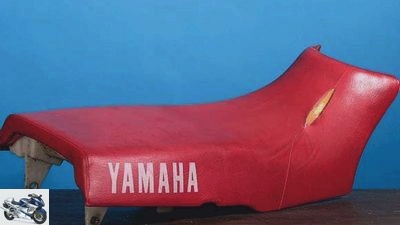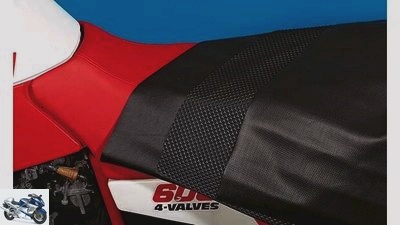Table of contents

Bilski
counselor
workshop
This is how it works: Replace the seat
That’s how it’s done
Renew the seat
Come on: shift your frustration to your old bank. Tear up the cover and foam – then re-upholstery.
07/06/2009
A few years ago, when everything was new, you could go along forever. And now? After two or three hours you get frustrated: your butt hurts because the foam pad is completely flat. In addition, the cover has become quite unsightly, even shows cracks. The driver does not want to admit how much the poor bench has suffered from the many trips together. But why suffer when the first signs of relationship stress appear? The accessories trade offers replacement seat cores made of high-quality composite foam and matching new covers. Fortunately, the costs are kept within limits; branded jeans are usually more expensive. And the renovation work is not particularly time-consuming either. 2Rader provides instructions for replacing the seat – so that it runs smoothly again for many thousands of kilometers.
Do it yourself

Bilski
Alternatively: universal covers with different surfaces.
A technically skilled person needs a little more than an hour to renew the bench. For example, Gotz Motorsport GbR (Telephone 0 74 76/93 30; www.goetz-motorsport.de) sells covers based on the originals from 24 euros. However, there are only remnants of the former Gotz GmbH, especially for enduros and crossers. Foam cores in their original form cost 56 euros at Gotz, universal parts 40 euros. At Louis (Tel. 0 40/73 41 93 60, www.louis.de) there are type-specific seat covers (from 29.95 euros) as well as universal seat covers from Kahedo (from 19.95 euros) and universal foam (44, 95 euros). Polo (Tel. 01 80/5 22 57 85, www.polo-motorrad.de) has two universal covers in its range (from 33.95 euros). To handle universal parts: Lay the original cover flat on the rectangular universal seat cover and then cut it to size with a few centimeters of safety allowance. In order to shape a universal foam precisely (preferably with an electric kitchen knife), great skill and a lot of time are required. Recommendation for laypeople: Leave this work to a professional saddler. It’s more expensive, but it is easy on the nerves.
Step by step

Bilski
First step: down with the broken cover. To do this, lever out all clamps with pointed pliers or a screwdriver. Then remove the foam seat core – no problem if it is not glued to the platform, as is the case with the XT 600 shown here. If so, stubborn foam residues can be rubbed off with a wire brush. Now place the new cover on the retrofit seat core and align it appropriately.
As a dry exercise, knock the ends of the cover and the thin foam lamination glued to the seat core evenly around the bench platform. Existing seams, like here on the model-specific Kahedo cover, make alignment work much easier. If the new cover sits in the middle and straight, it is first fixed together with the lamination on the front of the bench with a few clamps.
Use a standard staple gun from the hardware store for this. The brackets should be six or eight millimeters thick. Tip: Get both clamp strengths and use them according to the different thick areas of the plastic seat shell, as the eight-millimeter clamps can penetrate too far in thin places and damage the new cover. After the cover is attached to the front, warm it up over a large area with a hairdryer, pull it back firmly and fix it again with a few clamps on the back. Then heat the cover flat again with the hair dryer and pull it around the edge of the bench at the lowest point. Before stapling, make sure that the cover protrudes as evenly as possible on the right and left side.
It doesn’t matter that it only protrudes a few millimeters in some places when cold – too little to be properly attached. When heated, it stretches two to three centimeters. If the material cools down again after fastening, the cover gets the necessary tension. It pulls itself tight, so to speak, without being glued to the seat core. There are no unwanted wrinkles. The hair dryer takes on a crucial role, especially in tricky areas such as the corners. Very important: do not heat up selectively, but always over a large area, then pull the cover over the critical point on the plastic shell and staple it immediately.
Just as important: do not just attach the clips in a circle, but rather reduce the space between the clips that are already in place until the cover is evenly stretched.
Then remove the protruding material of the foam lining with scissors or a sharp knife.
Finally, check all areas of the bench for accuracy of fit. If everything fits well, it’s time to take a seat and drive off.
Have fun.
Related articles
-
This is how it works: motorcycle care
accesories This is how it works: motorcycle care This is how it works: motorcycle care With these tips, your motorcycle will sparkle again as if it were…
-
This is how it works: Remove rust from the tank
counselor workshop This is how it works: Remove rust from the tank This is how it works: derust the tank How do I get rid of the rust? Rotten fuel…
-
This is how it works: Transport the motorcycle
Motorcycle transport solutions Caravans, mobile homes, trailers, transport systems archive counselor workshop This is how it works: Transport the…
-
This is how it works: Adjust the spring base yourself
accesories landing gear & Spring elements This is how it works: Adjust the spring base yourself This is how it works: Adjust the spring base Adjust the…
-
Balancing motorcycle tires – this is how it works
wolf 8th pictures wolf 1/8 Haweka balancing professional Uwe Westermann at the versatile Bike Boss Louis 2/8 Static yes, dynamic no: balancing stands…
-
This is how a tempo control works
Bilski counselor traffic & business This is how a tempo control works This is how a tempo control works What if it flashes red? Then comes a ladle or…
-
Both systems replace the pillion seat as a luggage rack.
Uli Baumann 23 pictures Uli Baumann 1/23 Many modern motorcycles only have a slim rear end – unsuitable for transporting luggage. MOTORRAD has tested two…
-
SW-Motech seat conversion customization online configurator
Dentges 16 pictures Dentges, SW-Motech 1/16 We checked the new service from SW-Motech on site and looked over the shoulder of the saddler. Dentges,…
-
This is how the new super sports technology works
Suzuki 20th pictures Suzuki 1/20 The Suzuki GSX-R combines high tech with clever engineering. Suzuki 2/20 This centrifugal force mimic adjusts the timing…
-
Cook 11 pictures wolf 1/11 The cover and upholstery core need a stable substructure. It’s called a tub, weighs several hundred grams and consists of…